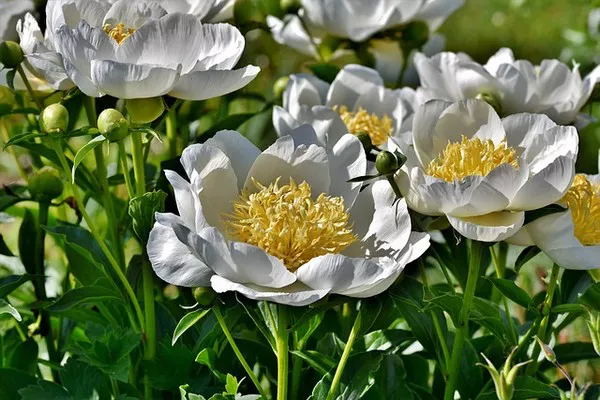Peonies, with their opulent blossoms and delicate fragrance, are beloved additions to gardens around the world. However, the journey from planting to full bloom can be a test of patience for even the most dedicated gardener. Understanding the factors influencing peony flowering time is crucial for cultivating these majestic flowers successfully.
Introduction to Peonies
Peonies belong to the genus Paeonia and are native to Asia, Europe, and North America. They are perennial plants, meaning they live for multiple years, and are prized for their large, showy flowers and lush foliage. Peonies come in a variety of colors, including white, pink, red, and even yellow, and are classified into three main types: herbaceous, tree, and intersectional (or Itoh) peonies.
The Growth Cycle of Peonies
To understand the flowering time of peonies, it’s essential to grasp their growth cycle. Peonies have distinct growth stages:
1. Dormancy: During winter, peonies enter a dormant phase, where their above-ground growth dies back, and they store energy in their roots.
2. Emergence: In spring, as temperatures rise, peony shoots emerge from the ground.
3. Foliage Growth: The plant’s foliage grows rapidly, fueled by stored energy reserves.
4. Bud Formation: Peonies form flower buds, which gradually develop into the stunning blooms they are known for.
5. Flowering: The buds open into fully bloomed flowers, typically in late spring to early summer.
6. Post-Flowering: After flowering, peonies may produce seed pods if pollinated. The foliage continues to grow, capturing sunlight to replenish the plant’s energy reserves for the next growing season.
7. Dormancy (Again): As temperatures drop in fall, peonies enter dormancy once more, preparing for the winter ahead.
Understanding this growth cycle provides insight into the timeframe for peony flowering.
Factors Affecting Flowering Time
Several factors influence how long it takes for peonies to flower:
1. Peony Type: Different types of peonies have varying flowering times. Herbaceous peonies typically bloom first, followed by tree peonies and intersectional peonies. Additionally, early, mid-season, and late-flowering varieties within each type offer options for extending the blooming season.
2. Climate: Climate plays a significant role in peony flowering time. Peonies thrive in temperate climates with distinct seasons, where they experience a period of winter dormancy followed by spring emergence. Warmer climates may have shorter dormancy periods and earlier flowering times, while colder climates may delay emergence and flowering.
3. Location: The specific location within a garden can affect peony flowering time. Peonies prefer well-drained soil and full sun, although they can tolerate partial shade. Inadequate sunlight or overly wet soil may delay flowering.
4. Soil Quality: Soil quality impacts peony growth and flowering. Peonies prefer fertile, loamy soil with good drainage. Amending soil with compost or organic matter can improve soil structure and fertility, promoting healthy growth and earlier flowering.
5. Plant Age: Young peony plants may take several years to establish before reaching maturity and producing abundant flowers. As peonies age and develop larger root systems, they typically flower more prolifically.
6. Cultural Practices: Proper care and maintenance contribute to timely peony flowering. Practices such as regular watering, mulching, and fertilizing can support healthy growth and flowering. Pruning dead or damaged foliage in late fall or early spring helps promote new growth and flowering.
7. Varietal Differences: Within each type of peony, different cultivars may have varying flowering times. Some cultivars are bred for early or late flowering, allowing gardeners to select varieties that suit their preferences and climate conditions.
Typical Flowering Timeframes
While the exact flowering time varies depending on the factors mentioned above, peonies generally follow a predictable timeline:
1. Herbaceous Peonies: These typically bloom in late spring to early summer, with flowering occurring around May to June in temperate climates. Some early-blooming cultivars may flower as early as April, while late-blooming varieties may extend the flowering season into July.
2. Tree Peonies: Tree peonies tend to bloom slightly earlier than herbaceous peonies, often in late spring. Flowering time can vary depending on the cultivar and climate conditions.
3. Intersectional Peonies: Intersectional peonies, a hybrid of herbaceous and tree peonies, typically bloom in mid to late spring, bridging the gap between the two types.
Gardeners can anticipate peony flowering by monitoring the growth and development of their plants throughout the growing season.
Tips for Encouraging Earlier Flowering
While peonies have their own internal timetable for flowering, there are steps gardeners can take to encourage earlier blooming:
1. Choose Early-Blooming Varieties: Select cultivars known for their early flowering to enjoy blooms sooner in the season.
2. Provide Optimal Growing Conditions: Ensure peonies are planted in well-drained soil with adequate sunlight exposure. Amend soil as needed to improve drainage and fertility.
3. Mulch and Fertilize: Apply organic mulch around peony plants to conserve moisture and regulate soil temperature. Additionally, fertilize peonies in early spring with a balanced fertilizer to provide essential nutrients for growth and flowering.
4. Prune Carefully: Prune dead or damaged foliage in late fall or early spring, being careful not to remove emerging buds. Pruning promotes new growth and can help synchronize flowering.
5. Monitor Watering: Keep peonies evenly moist, especially during dry spells or periods of hot weather. Avoid overwatering, as excessively wet soil can hinder flowering.
By implementing these strategies, gardeners can help ensure their peonies flower earlier and more abundantly.
Conclusion
Peonies are prized for their luxurious blooms and enduring beauty, but achieving timely flowering requires careful attention to various factors. Understanding the growth cycle of peonies, along with the influence of climate, location, soil quality, and cultural practices, is essential for successful cultivation. While peonies may take several years to establish and reach their full flowering potential, thoughtful planning and care can lead to a spectacular display of blooms each spring. With the right approach, gardeners can enjoy the timeless elegance of peonies in their gardens for years to come.


